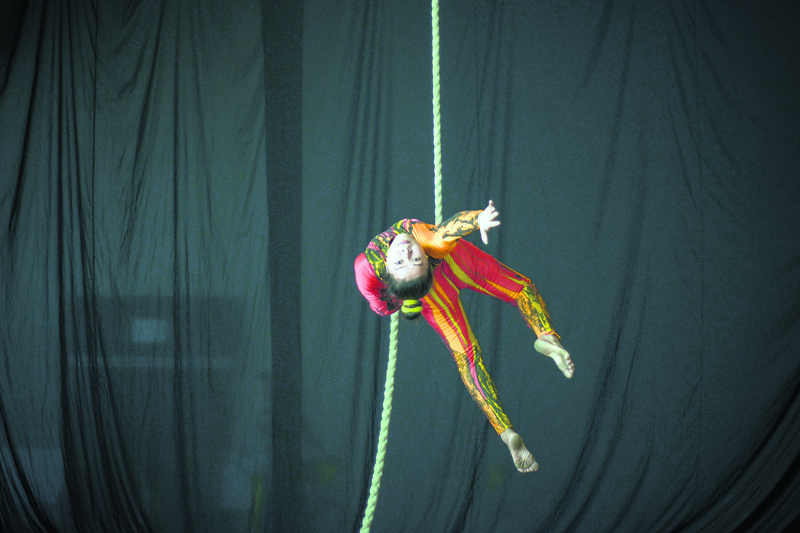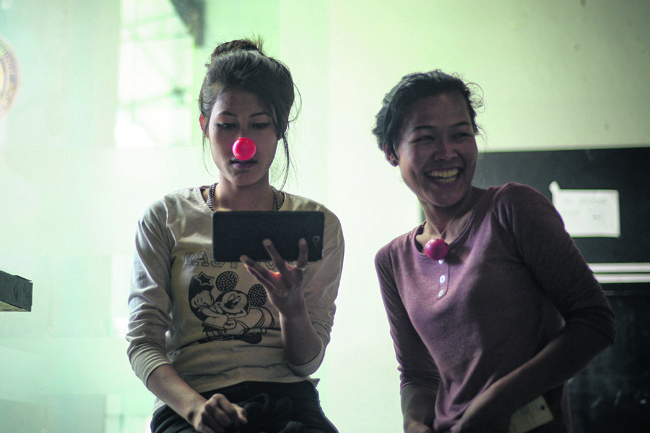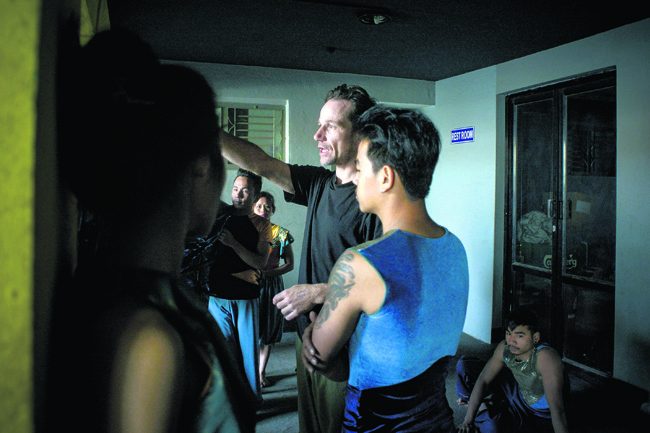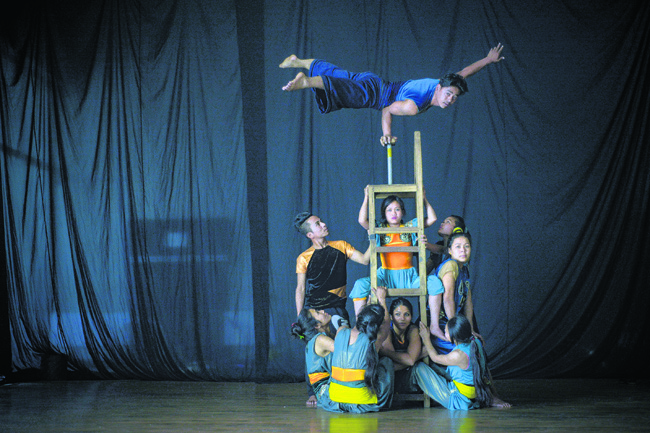
OR
Cover Story

Saraswati Adhikari was trafficked to India from her village in Hetauda, Nepal when she was just nine years old and forced to train and perform in a traveling circus. Her parents searched high and low for her but she could only be reunited with her mother after a decade, following her rescue seven years ago. Her father had passed away by then, and she had had three children already.
“I was brought up in a circus in India and the owner of the circus got me married off when I was 14 years old. By the time I was 15, I had given birth to twins and when I was 20, I delivered another child,” says Adhikari who specializes in hula-hoop, unicycle, and aerial stunts. Watching her perform is like watching the unbelievable happen right before your eyes. She’s nimble on her feet and her body seems to defy gravity.
Adhikari, now 28, is a member of Circus Kathmandu, Nepal’s first and only company whose performers have all been rescued from trafficking and the streets. Adhikari talks about how circus is a huge part of the person she is and that she’s determined to chart out a life from it. But things are far from easy. Adhikari mentions that word ‘circus’ itself has a bad reputation and people don’t see circus performers as the artists they are.
25-year-old Bijay Limbu, another member of Circus Kathmandu, agrees. Limbu claims that the concept of circus is misunderstood in Nepal and because of that there’s a negative connotation associated with it. He wants to change people’s mindset about it and, for that, is training hard to better his acts.
“Nowadays circus isn’t only about stunts. There is story and drama in the acts,” says Limbu who besides performing also looks after the overall production aspect of the circus. Limbu says that though in his decade long journey as a circus performer he has come a long way, there is still much for him to learn.
And, Limbu and the 10-member team of Circus Kathmandu are enthusiastic about making the best of their circus skills and practice for at least six hours every day. Also since, like Adhikari said, circus is a big part of their lives, they don’t see themselves doing anything else. But is the circus life enough to sustain themselves and their families especially since Circus Kathmandu is run largely on fundraiser shows and donations? Even their trainers are volunteers.
Chiara Zubiani, volunteer trainer at Circus Kathmandu, says that the circus has a social approach and it’s only recently that they have started taking it up more professionally. To sustain themselves, and in turn Circus Kathmandu, they are working on the Dinner Show which will be a ticketed event at Tangalwoods in Kathmandu.
“These young boys and girls definitely need more training. They have the potential to do much more but they need direction,” says Zubiani adding that the Dinner Show they are working on is the beginning of a long process. But according to Zubiani, not everything is dependent on the performers themselves. In terms of resources and support, Circus Kathmandu needs all the help it can get. Sponsorships, a good training team, and better space and equipment are definitely some of the basic requirements that could be focused on.
“Most of the materials they have are second-hand stuff. They are things that have been donated by other circuses around the world. It will be different to have things of your own,” she explains. Also talking about the soon-to-be launched Dinner Show, Zubiani says that the two trainers are doing a job that usually takes 10 people to do. And true to their word, you can actually see the trainers run around micromanaging the stage set-up, equipment layout and all else that goes into the making of a circus show.
Mark Duncan, another volunteer trainer and director of the Dinner Show, says that though there are no issues with hand-me-downs, as an added safety measure they have to make sure they rigorously check it all before each practice session or show. Safety is also a concern, not just in terms of being accident safe but the performances themselves can result in torn muscles and ligaments.
Despite the hardships and hurdles, the team definitely seems to have accomplished quite a bit. The team recently premiered a new show in Pokhara at the jungle festival. It is the same show that is going to be redeveloped for the Dinner Show and there is still a lot of work to be done for it. Circus Kathmandu has also already performed in Dubai, Norway, Australia, and UK.
“I want to create shows with Nepalipan in them and then perform them abroad. I speak for the entire team when I say we want to create an impact through our acts,” says Lama adding that they recently staged shows at 30 places of rural Nepal to make people aware about child marriage.
The only thing that seems to drag them down a bit is the fact that societal acceptance is still, at large, missing. “Maybe it’s a cultural thing where circus is regarded poorly. Some performers aren’t confident enough to say they are circus artists,” says Zubiani adding that since they like what they are doing they shouldn’t worry about what others think.
And Adhikari agrees with Zubiani. She is content that she is able to take care of her kids on her own now that her husband has passed away and that people know who she is based on the few acts she’s done in Kathmandu. She mentions that another positive aspect of circus in her life has been the fact that her body is agile and fit due to tough training sessions. However, she also says that there is a lot left to accomplish including changing people’s mindset about circus.
Trainer Duncan, on the other hand, believes that the change will eventually come through their hard work and dedication, and that they need to train more and train better for that. Currently, he mentions he is getting the crew members to do aerial training even though only half of them are aerial artists. According to Duncan, one needs great strength to be a circus artist. They have to work on building their muscles and stamina.
“The good thing is that these artists are young. They are at a stage where they can make the most of their age and the physical ability that comes with it,” says Duncan.
cillakhatry@gmail.com



You May Like This

Prem Geet 2: Hope for true love, hope for better films
Though set in Burma, ‘Prem Geet 2’ from the very start talks about nationalism and tries to promote the rich... Read More...

As 2017 ends in good notes, investors hope for stable govt in 2018
KATHMANDU, Dec 31: Record economic growth of 7.5 percent, end of load-shedding, and successful conduction of three elections have been some... Read More...

Senior citizens hope to take one last shot at polls
KHOTANG, April 18: It has been more than 19 years since octogenarian Goma Dahal of Rupakot cast vote the last time.... Read More...







Just In
- NRB to provide collateral-free loans to foreign employment seekers
- NEB to publish Grade 12 results next week
- Body handover begins; Relatives remain dissatisfied with insurance, compensation amount
- NC defers its plan to join Koshi govt
- NRB to review microfinance loan interest rate
- 134 dead in floods and landslides since onset of monsoon this year
- Mahakali Irrigation Project sees only 22 percent physical progress in 18 years
- Singapore now holds world's most powerful passport; Nepal stays at 98th











Leave A Comment